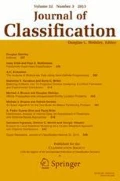Abstract
We examine the problem of aggregating several partitions of a finite set into a single consensus partition We note that the dual concepts of clustering and isolation are especially significant in this connection. The hypothesis that a consensus partition should respect unanimity with respect to either concept leads us to stress a consensus interval rather than a single partition. The extremes of this interval are characterized axiomatically. If a sufficient totality of traits has been measured, and if measurement errors are independent, then a “true” classifying partition can be expected to lie in the consensus interval. The structure of the partitions in the interval lends itself to partial solutions of the consensus problem Conditional entropy may be used to quantify the uncertainty inherent in the interval as a whole
Similar content being viewed by others
References
ARROW, K J (1951),Social Choice and Individual Values (1st edition), New York: John Wiley
ARABIE, P, and BOORMAN, S A (1973), “Multidimensional Scaling of Measures of Distance Between Partitions,”Journal of Mathematical Psychology, 10, 148–203
BOORMAN, S A, and ARABIE, P (1972), “Structural Measures and the Method of Sorting,” inMultidimensional Scaling Theory and Applications in the Behavioral Sciences, Vol 1 (Theory), eds R N Shepard, A K Romney, and S B Nerlove, New York: Seminar Press, 225–249
BOORMAN, S A, and OLIVIER, D C (1973), “Metrics on Spaces of Finite Trees,”Journal of Mathematical Psychology, 10, 26–59
BOYD, J P (1972), “Information Distance for Discrete Structures,” in Multidimensional Scaling: Theory and Applications in the Behavioral Sciences, Vol 1 (Theory), eds, R N Shepard, A K Romney, and S B Nerlove, New York: Seminar Press, 213–223
DAY, W H E (1981), “The Complexity of Computing Metric Distances Between Partitions,”Mathematical Social Sciences, 1, 269–287
GRATZER, G (1978),General Lattice Theory, New York: Academic Press
IYANAGA, S, and KAWADA, Y (1977),Encyclopedic Dictionary of Mathematics, Cambridge, Massachusetts: MIT Press
KELLY, J S (1978),Arrow Impossibility Theorms, New York: Academic Press
LECLERC, B (1984), “Efficient and Binary Consensus Functions on Transitively Valued Relations,”Mathematical Social Sciences, 8, 45–61
MIRKIN, B G (1975), “On the Problem of Reconciling Partitions,” InQuantitative Sociology, International Perspectives on Mathematical and Statistical Modeling, eds, H M Blalock, A Aganbegian, F M Borodkin, R Boudon, and V Capecchi, New York: Academic Press, 441–449
RENYI, A (1970),Probability Theory, Amsterdam: North-Holland
RUBIN, J (1967), “Optimal Classification into Groups: An Approach to Solving the Taxonomy Problem,”Journal of Theoretical Biology, 15, 103–144
Author information
Authors and Affiliations
Rights and permissions
About this article
Cite this article
Neumann, D.A., Norton, V.T. Clustering and isolation in the consensus problem for partitions. Journal of Classification 3, 281–297 (1986). https://doi.org/10.1007/BF01894191
Issue Date:
DOI: https://doi.org/10.1007/BF01894191




